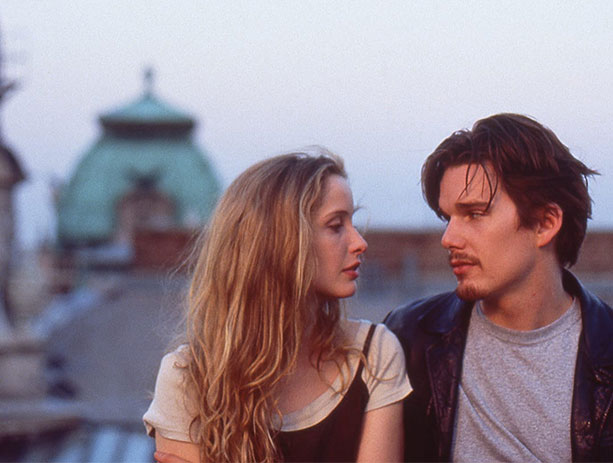By Jewel Konieczny
I first fell in love with Vienna on screen, in what is now one of my favourite films and the first of Linklater’s Trilogy: Before Sunrise. This year, I was fortunate enough to spend the summer semester there. Today, after five months, I’m leaving for the last time.

Despite being a city, Vienna retains a natural, old-world charm by virtue of its Baroque buildings and mild light. In film and in real life, lighting creates mood. In Vienna, it’s at once bright and incredibly soft, creating a gentleness in the face of the rare ‘Wiener Grant’. In the early evenings, golden light spills into the built-up space, illuminating the tall, uniform buildings such that they seem natural, too. Evenings, as always, carry quite a finite feeling, despite the promise of many more long, bright days. It’s a feeling somewhat like nostalgia, that hits me even stronger in retrospect. Set within 500 acres of grounds, the Schonnbrunn palace was one of my favourite places to enjoy Vienna’s sunny days. Once the summer residence of the Habsburg rulers, the palace is overlooked by the Gloriette triumphal arches – a monument set on a hill, with views stretching over the Danube. Below, winding paths lead to several cafe’s nestled in trees, which themselves are home to dozens of Eurasian red squirrels. Even away from the gardens, where darkness shrouds the city, Vienna’s lights are warm and non-polluting. In this way, the light and dark meet in harmony, and complement each other more than in their absence.
Vienna is a diverse city, with 43% of its population being non-native to Austria. As such, it is a melting pot of cultures, laden with passionate people. As you move through the city, you will find hopeful words everywhere, from scribbles on elevator walls, to the drapes on ageing buildings. Here, I find most people are quite reserved, although honest and mostly very kind. You can be quite sure that if they’re nice to you, then they really mean it, which isn’t always true of other places. After five months, I’m fortunate to know a few of them well enough to call them friends. I know their drink order and I can hear their voices in my mind, such that they are distinct from the thousands of others I’ve heard in my life. But I don’t know them well enough to be sure I’ll ever see them again. It’s a difficult thing, when you’re not quite close enough. Nevertheless, I remind myself that I’m lucky to have met them at all, and as much as I’d love to stay, there’s no need to devalue the time for being too short. Sometimes, being friends for a while is enough.
Every so often, I spent my evenings at the Burg Kino, one of the oldest operating cinemas in the world. Dating back to 1912, a period of black and white silent films – the auditoriums are fitted with classic red velvet seats, that neither recline nor have cup holders. Preserved to this day, the building has a vintage feel that rejects modernisation. The cinema screens a variety of genres, from Viennese classics like The Third Man, to documentaries – including Poitras’, All the Beauty and Bloodshed. With its quaint, tiered auditoriums the Burg Kino makes a nostalgic place to spend a few hours at night, or on a rainy day.
When I had time, I would also take trips outside the city. Austria is a landlocked country, making it well-connected to many European countries. From Vienna, the most accessible of these lie to the north or the east. By bus, I visited three countries that were all within four hours of the city, with each journey being under 25 euros. The easiest trip from Vienna is the one-hour drive to Bratislava, Slovakia – although you can also reach the city by aeroplane, train, or boat. Although a small city, it has a rich history, influenced by many nations, cultures and religions. Nestled amid the contemporary structures are its surviving medieval towers and baroque palaces. However, perhaps one of the most famous buildings is the city’s Church of St. Elisabeth, better known as the “Blue Church”. Built entirely in the Hungarian Secessionist style, it adorns a quasi-oriental style that opposes the influence of the West. With its rounded edges and intricate ornamentation, it looks a lot like a wedding cake.
No doubt, the places and events mentioned here occupied just a tiny slice of the time I spent here. There are infinite others: cafes, restaurants, museums – vintage shops and the people in them. And for the hundreds of things I did, there were equally as many things I didn’t do. That’s what I regret: what I might have missed out on, and because I wasn’t there there’s no way to ever find out what might have been. I don’t know where these inhibitions come from. In my case, it’s probably anxiety. But I’ve learnt that there is a difference between not wanting to do something, and being afraid of doing it. Often, taking chances won’t amount to the greatest moment of your life. A lot of them will probably affirm your earlier desire to stay at home in bed, or stay in England for yet another semester on the South Coast of England. I was afraid I would fail my classes in a different education system, or that I would be lonely. The reality can go either way. I didn’t fail my classes, and I was lonely sometimes. But for the most part, you can trust your gut to – sooner or later, take you somewhere you want to be.
The trouble now, is how to leave.












About me: I’m a 3rd year Philosophy and English student from the University of Southampton. I spent the second semester of my 2nd year studying abroad at the University of Vienna.
